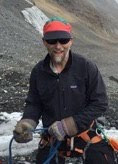Getting out of town:
Getting everything ready for this trip happened quickly. I had one
week between returning from Svalbard and shipping my gear to
Greenland. In addition, I still needed one test run for my Physical
Qualification (PQ), which NSF requires of all participants in the
Arctic and Antarctic programs. The TB test, as usual, was negative,
so I'd faxed the results to the NSF doctor and figured it was now just
a matter of time for my PQ to come through. Then 3 days before we
were to leave, I got an email from the NSF medical office- they were
missing one blood test. I'd had so many blood tests that the nurse
drawing blood from my arm had to use 13 vials to collect it all. When
the results came, I just sent them all in, but didn't see that one was
missing amid the rest.
This could put a serious damper on my season, as I won't be able to
stay at Summit if the PQ doesn't come through. I investigate with my
doctor, and it turns out a consent form had not been signed for the
tests and so they weren't done. We quickly sign the form and get it
started, but the tests will take a few days. I'll keep calling
them. I call them every couple of days while in transit, each time
hoping for the news that the results have come in, but each time it's
the same answer: no results yet.
I spend a day flying West to East, and my backpack misses a tight
connection in Dulles. I explain to the baggage handlers that I'm
flying to Greenland in the morning (at 5:30) and that I'd really like
to have the bag. I can manage without it, but I'd prefer to have it,
all the same. They'll see what they can do. I get to sleep, and
then at 1:30 the phone rings; my backpack has arrived. I go down and
get it and then go back to bed. 3 hours later my alarm wakes me for
the flight to Kangerlussuaq.
To Raven- 4th time's the charm!
After an uneventful flight to Kangerlussuaq, followed by some cargo work in the
evening, this morning I got up and got ready for the trip out to Raven. My
first orfder of business was to call England to see if my lab tests
have shown up yet- no word, so I'll try again when I get back
tomorrow.
My "showtime" for the flight was 9:30, so I came down packed and ready
to go. There was some time waiting, but then the call came to hurry
to the plane. On the plane, strapped in, ready to go, and then one by
one I heard the engines shutting down. Usually they leave on the
auxiliary power unit (APU), but this shut down as well, and I knew
something was amiss. Then all the lights went out, and I heard the
words "exit the aircraft"- we all got off pretty quickly!
It turned out that there was a possible fault with the wing de-icing
heaters, and that one of them might be overheating. Since the fuel is
also stored in the wings, this would be bad. As they were working on
diagnosing the problem, someone smelled that 'hot' smell, so we
evacuated the aircraft and all gathered away from it while we waited
for the fire crew to arrive. After we had the all-clear, we later
learned that the sensor was probably faulty, and the smell might have
been the exhaust of a passing poorly-tuned pickup truck. So we went
back for another try. This time there seemed to be a problem with the
generator on the #1 engine, so we skipped that attempt as well. In the
end, that mission was scrubbed and my gear and I were transferred to
the next plane headed to Raven, but I got there nonetheless.
At Raven I met Mark and Lou, old friends and the current residents of
Raven. It's always to see them. I quickly got all the additional
gear I needed, and got going.

Mark and Lou at the 'helm' of raven camp.
A big grin forms on my face as I drive out into the flat white
untracked snow. This is the part I love. I arrive, find my sites,
add casing to the holes, log them, finish by 9pm and head back to
camp. I had a lovely dinner with Mark & Lou, then showed off some
photos of my daughter
Olivia, then went to bed.
Next day:
I awake at Raven, have a nice breakfast and coffee with Lou and Mark.
The plane arrives. I head back to Kanger, then set to work dealing
with the medical. Now the lab is done with my bloodtests, but they
haven't sent it to my doctor yet. More phone calls, and at the last
minute (it's 5:30 pm British time) the fax comes through- the blood
test results, and as we knew, I don't have hepatitis :). Then the
race is to get the results to NSF medical, so I can be PQ'd for the
flight tomorow. A few faxes and emails later, I'm pronounced good to
go, so we're on for tomorrow. Then I do some re-packing and catch up
with some old classmates Ginny and Tom. It was great to see them, if even only for a short time. Now off to Summit, More on that tomorow!

















